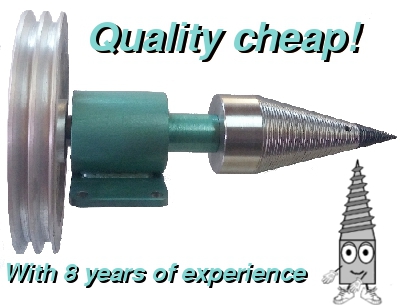
Questions and answers about splitting cones in one place!
Should logs be split in vertical or horizontal position?
- Logs should always be standing upright when being split. If you try to split logs laid down horizontally, the cone will be jammed and the load will be applied on the shaft in a vertical direction, causing a slow material (shaft) fatigue, which will eventually break the shaft.
Incorrect placement! (Picture 1 and 2) |
|
|
Correct! (3 and 4 picture)
|
|
|
What is the recommended position for the cone and the anti-slew device?
- The arrangement shown in the picture provides a simple rule of thumb for the approximate positioning of the cone and the blocking device.
During actual use, these values may show minimal deviation from the perfect setting.

Why does the wood not rotate during splitting?
--The splitting cone is generally at 1/3 of the height of the log, i.e. if the log is 30 cm high, the tip of the cone should be positioned at a height of 8-10 cm. Slewing can also be prevented by placing a wedge (an essential accessory) under the splitting cone.
What should I keep in mind, what are the most common errors?
If the tip is blunt and the wood does not split before the tip to make way for the cone, it can cause the cone to get stuck or require a much higher force to be applied on the wood. When using properly designed tips and thread profiles, the cone and the thread will allow you to almost effortlessly pull the wood onto the cone. |
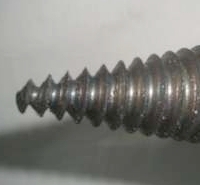 |
|
If the tip is blunt and the thread pitch is too high, it creates another problem. You do not want to drill the ground, you want to achieve splitting with the cone. A blunt tip and a high pitch requires significantly larger performance, causing increased power consumption. |
|
|
The screwdriver design is good for corks, but it is less than ideal for splitting wood. The problem is that the tip gets chipped off easily. That’s why only a few manufacturers provide warranty for breakage and chipped-off tips. If this occurs, we will replace the tip free of charge. |
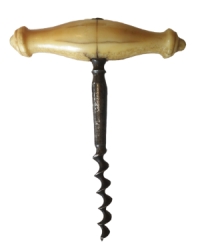
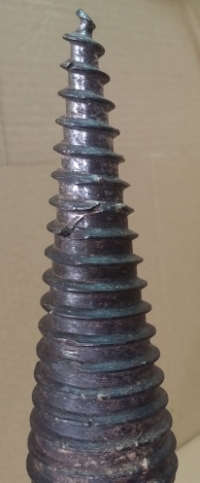
|
|
Too small cone angles can cause a risk of breaking. |
|
NEVER have screws protruding from the body of rotation! Unless the purpose is to cause damage. |
|
How much power is necessary for the splitting?
- It depends on the type of the wood, if we want to split log or meters of wood, also depends if we want to drive the cone directly or with transmission.
In what rev range should we use the splitting cone?
- At 250-500 RPM, depending on what kind of wood and drive is used.
Why the double-start thread is better than a single?
- The single-start threads usually drill into the wood harder than the double-start threads therefore - to be able to start the splitting - these are sharpened too much and so the tip breaks off more easily. Also the double-start thread cones due to the cross edge drill the gnarled parts apart more easily.
What is the variable thread pitch?
- Starting from the beginning of the splitting cone the pitch of the thread grows steadily. Thread pitch: distance traveled during one turn, in this case in the wood and the distance is in millimeters.
What is the advantage of the variable thread pitch?
- At the tip of the cone the pitch is smaller so it gets more easily into the wood than the cones with normal pitch. Therefore less force is required to start the splitting.
Is there a need for a deep thread pit?
- No, because the wood splits before filling the deeper thread pits. The cones with too deep thread pit get into the wood harder.
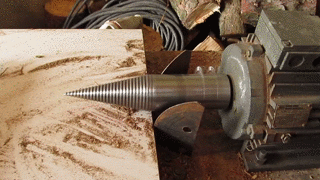
If the thread profile is too deep, the tip will have an incorrect shape making it difficult for the cone to bite into the wood, while high rpm values and high pitches will cause the cone to grab the wood too quickly, making the splitting difficult to perform. Operating under these conditions is unsafe; therefore, this solution must be avoided! Protruding screws and sharp baffle plates can also create hazards.
What is the ideal shaft size?
- From safety point of view the minimum 35mm size shafts are appropriate. This way you have to funk of splay or fraction due to fatigue less.
What belt pulley should I choose?
- When choosing the pulley, the revolution of the motor should be taken into account. It is recommended to mount a two-row (double) pulley, preventing the belt from slipping when encountering higher resistances
The smaller belt pulley should have a diameter of 100 mm or more, this way we can increase the service life of the belt.
Recommended belt widths: 13 mm and 17 mm. Here is a simple example to calculate revolution per minute: a motor with 1440 rpm, 100 mm pulley on the motor and 300 mm pulley at the top. In this case the revolution will be divided by three: 1440/3 = 480 rpm.
Why does the V-belt slip?
- It is likely that the belt does not fit on the pulley correctly (the belt is too wide, high or narrow). Most often the inside flange surface of the belt gets seated on the pulley, rendering the lateral sections of the belt unable to transmit proper friction force onto the pulley.
Proper seating is shown in the illustration.
 What V-belt should I choose?
What V-belt should I choose?
- Instead of coated belts with normal profile it is recommended to use cogged V-belts which provide a more accurate seating and allow better torque transmission. These belts are also more flexible and therefore have a longer service life.
Is the heat treatment necessary for the whole cone?
- No, because the tip is that drills into the wood and starts the splitting of the wood, this part is exposed to more stress so it's enough to harden only the removable tip or the front of the cone.
The cone is shell-hardened. It's an inductive surface hardening which allows keeping the core toughness and makes it much more resistant against weary stress so you don't have to be apprehensive of any tip brake off.
(The cone won't become rigid in its entire cross-section!)
Is it recommended to install the cone directly to an electric motor shaft?
- No because it wrecks the bearings of the electric motor! The rev will be too much so it will be dangerous and the splitting wouldn't ideal as well. Probably the shaft diameter won't meet the recommended size too.
What V-belt pulley should I choose?
- When choosing the pulley the rev of the motor should be taken into account. It is recommended to mount a double-row (double) pulley so the V-belt couldn't slip at higher resistance. Proposed belt widths are 13 and 17mm. A simple example to calculate the rev: 1440 RPM motor, 100mm diameter pulley at the motor and a 300mm pulley to the top which means we have to third the rev:
1440/3 = 480 RPM
What size of splitting cone should I choose?
- It depends on the size of the wood. We recommend the smallest, 60 diameter cone for log splitting up to 30-40cm. The 80 cone is for log and thinner meter of woods. The 110 cone is for log and thicker meter of woods.
How powerful electric motor should I choose?
- The 60 cone is recommended from 2kW, the 80 from 3kW and the 110 from 4-5kW.
Ø 60x270mm cone 2kW recommended |
Ø 80x260mm cone 3kW |
Ø 110x260mm cone 4-5kW |
|
|
|
Can I operate my splitter from one phase (230V) as well?
- Yes, we recommend the smallest 60 diameter cone for a one phase electric motor. It is advisable to purchase a larger pulley which functions as a flywheel as well. With a one phase electric motor we will be able to split mostly logs and less meters of wood.
Which thread design should I choose?
- Choosing the thread design depends on the direction of rotation. When facing the tip of the cone and it goes clockwise to the right hand we will need a left-hand thread, if it goes counterclockwise we will need a right-hand thread. If reversing is possible the thread design has no major role anymore, we can split with the left and right-hand thread equally.
Is it worth it to use the cone with a cultivator?
- No, because the rev will be too low and so the splitting won't be ideal as well. Its mechanical structure does not meet the safety requirements.
If you have any unanswered questions or if you need advice, contact us via email, we are ready to provide help.
|
